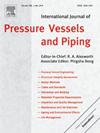Experimental evaluation of multiple-component residual stress distribution in a dissimilar metal repair joint of ferritic/martensitic steel using the asymmetric-cut and the symmetric-cut contour method
IF 3
2区 工程技术
Q2 ENGINEERING, MECHANICAL
International Journal of Pressure Vessels and Piping
Pub Date : 2024-09-26
DOI:10.1016/j.ijpvp.2024.105333
引用次数: 0
Abstract
A thick multi-pass butt-welded ferritic/martensitic steel (P91) joint is prepared and the local region of the weld is repaired with an ENiCrFe-3 nickel-based alloy using the manual metal arc welding method. The repair weld including part of the base metal is then subjected to ultrasonic impact treatment (UIT). A three-cut contour method (CM), including two asymmetric cuts and one symmetric cut, is developed in the present study to obtain the two-dimensional (2D) residual stress distributions at different locations, and the stress release after multiple cuts is considered to get the original stress distribution before cuts. The measurement procedure is introduced in detail. The longitudinal stresses in the repair weld and the initial weld of the P91 steel joint, as well as the transverse stress at the weld center, are finally obtained. The effects of the dissimilar metal repair weld at the local region on the longitudinal and transverse welding residual stresses are investigated. In addition, the applicability of UIT to mitigate the surface stress in nickel-based alloy repair weld is analyzed. The results show that the transverse and longitudinal stresses in the nickel-based alloy repair weld are both tensile stresses, the maximum longitudinal stress is close to the yield strength of the B91 weld metal and occurs in the heat-affected zone of the repair weld located in the initial weld. Repair welding causes the internal transverse compressive stress region to be narrower than in the initial weld. UIT can be used to introduce compressive stress to the surface layer of the nickel-based alloy repair weld.
使用非对称切割和对称切割轮廓法对铁素体钢/马氏体钢异种金属修复接头中的多组分残余应力分布进行实验评估
制备了厚的多道对焊铁素体/马氏体钢(P91)接头,并采用手工金属弧焊方法用 ENiCrFe-3 镍基合金修复了焊缝的局部区域。然后对包括部分母材在内的修复焊缝进行超声波冲击处理 (UIT)。本研究开发了一种三切割轮廓法(CM),包括两次非对称切割和一次对称切割,以获得不同位置的二维(2D)残余应力分布,并考虑多次切割后的应力释放,以获得切割前的原始应力分布。详细介绍了测量过程。最终得到了 P91 钢接头修复焊缝和初始焊缝的纵向应力以及焊缝中心的横向应力。研究了局部区域的异种金属修复焊缝对纵向和横向焊接残余应力的影响。此外,还分析了 UIT 在减轻镍基合金修补焊缝表面应力方面的适用性。结果表明,镍基合金修补焊缝中的横向和纵向应力均为拉应力,最大纵向应力接近 B91 焊接金属的屈服强度,发生在位于初始焊缝的修补焊缝热影响区。修补焊接导致内部横向压应力区域比初始焊缝更窄。UIT 可用于在镍基合金修补焊缝的表层引入压应力。
本文章由计算机程序翻译,如有差异,请以英文原文为准。
求助全文
约1分钟内获得全文
求助全文
来源期刊
CiteScore
5.30
自引率
13.30%
发文量
208
审稿时长
17 months
期刊介绍:
Pressure vessel engineering technology is of importance in many branches of industry. This journal publishes the latest research results and related information on all its associated aspects, with particular emphasis on the structural integrity assessment, maintenance and life extension of pressurised process engineering plants.
The anticipated coverage of the International Journal of Pressure Vessels and Piping ranges from simple mass-produced pressure vessels to large custom-built vessels and tanks. Pressure vessels technology is a developing field, and contributions on the following topics will therefore be welcome:
• Pressure vessel engineering
• Structural integrity assessment
• Design methods
• Codes and standards
• Fabrication and welding
• Materials properties requirements
• Inspection and quality management
• Maintenance and life extension
• Ageing and environmental effects
• Life management
Of particular importance are papers covering aspects of significant practical application which could lead to major improvements in economy, reliability and useful life. While most accepted papers represent the results of original applied research, critical reviews of topical interest by world-leading experts will also appear from time to time.
International Journal of Pressure Vessels and Piping is indispensable reading for engineering professionals involved in the energy, petrochemicals, process plant, transport, aerospace and related industries; for manufacturers of pressure vessels and ancillary equipment; and for academics pursuing research in these areas.

 求助内容:
求助内容: 应助结果提醒方式:
应助结果提醒方式:


